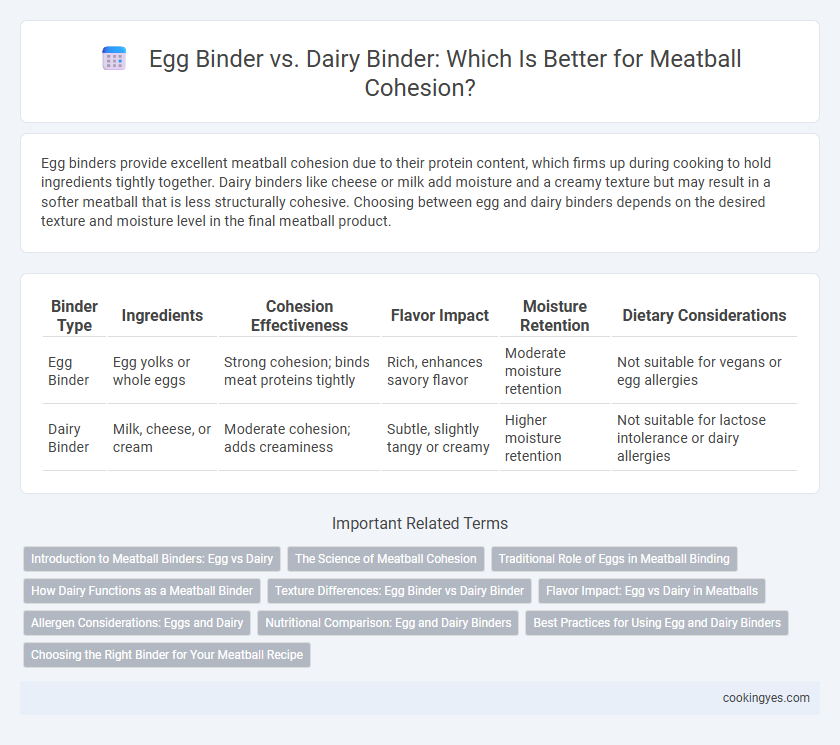Egg binders provide excellent meatball cohesion due to their protein content, which firms up during cooking to hold ingredients tightly together. Dairy binders like cheese or milk add moisture and a creamy texture but may result in a softer meatball that is less structurally cohesive. Choosing between egg and dairy binders depends on the desired texture and moisture level in the final meatball product.
Table of Comparison
| Binder Type | Ingredients | Cohesion Effectiveness | Flavor Impact | Moisture Retention | Dietary Considerations |
|---|---|---|---|---|---|
| Egg Binder | Egg yolks or whole eggs | Strong cohesion; binds meat proteins tightly | Rich, enhances savory flavor | Moderate moisture retention | Not suitable for vegans or egg allergies |
| Dairy Binder | Milk, cheese, or cream | Moderate cohesion; adds creaminess | Subtle, slightly tangy or creamy | Higher moisture retention | Not suitable for lactose intolerance or dairy allergies |
Introduction to Meatball Binders: Egg vs Dairy
Egg binders provide superior protein structure, enhancing meatball cohesion and moisture retention during cooking. Dairy binders, such as milk or cheese, contribute fat and mild creaminess, improving texture but offering less binding strength compared to eggs. Choosing between egg and dairy binders depends on desired meatball firmness, flavor profile, and dietary preferences.
The Science of Meatball Cohesion
Egg binders provide superior protein networks through albumin coagulation, enhancing meatball cohesion by trapping fat and moisture effectively. Dairy binders, such as milk or cheese, contribute casein proteins that improve texture but offer less structural integrity compared to egg proteins. Understanding the molecular interactions of albumin and casein is crucial for optimizing meatball firmness and juiciness in culinary formulations.
Traditional Role of Eggs in Meatball Binding
Eggs serve as a traditional binder in meatballs, providing essential proteins like albumin that coagulate during cooking to create a sturdy, cohesive texture. The lecithin in egg yolks enhances emulsification, ensuring even distribution of fat and moisture across the mixture for optimal binding. Compared to dairy binders, eggs offer superior structural integrity, making them a preferred choice for maintaining classic meatball consistency.
How Dairy Functions as a Meatball Binder
Dairy binders, such as milk, ricotta, or cream, enhance meatball cohesion by adding moisture and fat, which helps proteins in the meat to bind effectively during cooking. The calcium and casein proteins in dairy create a gel-like structure that traps fats and juices, improving texture and preventing meatballs from falling apart. Compared to egg binders, dairy offers a creamier, tender consistency while maintaining structural integrity.
Texture Differences: Egg Binder vs Dairy Binder
Egg binders create a firmer, more cohesive meatball texture by effectively coagulating proteins during cooking, which improves structural integrity. Dairy binders like milk or cheese contribute creaminess and moisture, resulting in a softer, more tender bite but less rigidity. The choice between egg and dairy binders significantly impacts the meatball's mouthfeel and ability to hold its shape under heat.
Flavor Impact: Egg vs Dairy in Meatballs
Egg binders in meatballs contribute a rich, savory flavor that enhances the overall taste profile, providing a slightly custardy undertone which complements the meat's natural juices. Dairy binders such as milk or cheese introduce a creamy, tangy dimension, adding moisture and a subtle sweetness that balances spices and herbs. Choosing between egg and dairy binders directly influences meatball cohesion and flavor harmony, with eggs promoting firmness and dairy enriching mouthfeel and juiciness.
Allergen Considerations: Eggs and Dairy
Egg binders provide strong meatball cohesion but pose allergen risks for individuals with egg allergies, which affects product labeling and consumer choice. Dairy binders like milk or cheese offer a different texture and moisture level but may trigger allergic reactions in lactose-intolerant or dairy-allergic consumers. Selecting between egg and dairy binders requires careful consideration of allergen prevalence to ensure safe consumption and regulatory compliance.
Nutritional Comparison: Egg and Dairy Binders
Egg binders provide high-quality protein and essential amino acids, contributing to meatball cohesion while adding vitamins like B12 and minerals such as selenium. Dairy binders, including milk or cheese, offer calcium and vitamin D, supporting bone health but also increasing saturated fat content. Choosing between egg and dairy binders impacts the nutritional profile of meatballs, balancing protein quality against fat and micronutrient contributions.
Best Practices for Using Egg and Dairy Binders
Egg binders provide superior protein structure and moisture retention, making them ideal for meatball cohesion in traditional recipes. Dairy binders like milk or cheese add fat and creaminess, enhancing flavor while offering moderate binding strength. Best practices involve balancing egg proteins for firm texture with dairy's fat content to achieve optimal juiciness and bite in meatballs.
Choosing the Right Binder for Your Meatball Recipe
Egg binders provide superior moisture retention and structural integrity, making them ideal for juicy, tender meatballs. Dairy binders such as milk or cheese add a subtle creaminess and help with slight expansion during cooking, enhancing texture without overpowering other flavors. Selecting the right binder depends on the desired consistency, flavor profile, and dietary restrictions of the meatball recipe.
Egg Binder vs Dairy Binder for Meatball Cohesion Infographic

 cookingyes.com
cookingyes.com